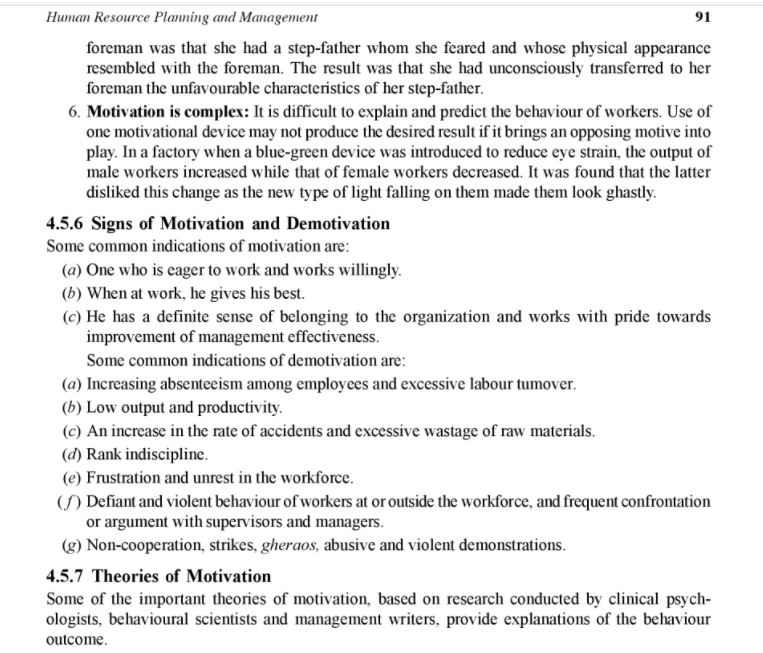Some common indications of motivation are: (a) One who is eager to work and works willingly. (b) When at work, he gives his best. (c) He has a definite sense of belonging to the organization and works improvement of management effectiveness. Some common indications of demotivation are: (a) Increasing absenteeism among employees and excessive labour tumover (b) Low output and productivity. (c) An increase in the rate of accidents and excessive wastage of raw materi (d) Rank indiscipline. (e) Frustration and unrest in the workforce.
Some common indications of motivation are: (a) One who is eager to work and works willingly. (b) When at work, he gives his best. (c) He has a definite sense of belonging to the organization and works improvement of management effectiveness. Some common indications of demotivation are: (a) Increasing absenteeism among employees and excessive labour tumover (b) Low output and productivity. (c) An increase in the rate of accidents and excessive wastage of raw materi (d) Rank indiscipline. (e) Frustration and unrest in the workforce.
Management, Loose-Leaf Version
13th Edition
ISBN:9781305969308
Author:Richard L. Daft
Publisher:Richard L. Daft
Chapter12: Managing Human Talent
Section: Chapter Questions
Problem 3ED
Related questions
Question

Transcribed Image Text:Human Resource Planning and Management
91
foreman was that she had a step-father whom she feared and whose physical appearance
resembled with the foreman. The result was that she had unconsciously transferred to her
foreman the unfavourable characteristics of her step-father.
6. Motivation is complex: It is difficult to explain and predict the behaviour of workers. Use of
one motivational device may not produce the desired result if it brings an opposing motive into
play. In a factory when a blue-green device was introduced to reduce eye strain, the output of
male workers increased while that of female workers decreased. It was found that the latter
disliked this change as the new type of light falling on them made them look ghastly.
4.5.6 Signs of Motivation and Demotivation
Some common indications of motivation are:
(a) One who is eager to work and works willingly.
(b) When at work, he gives his best.
(c) He has a definite sense of belonging to the organization and works with pride towards
improvement of management effectiveness.
Some common indications of demotivation are:
(a) Increasing absenteeism among employees and excessive labour tumover.
(b) Low output and productivity.
(c) An increase in the rate of accidents and excessive wastage of raw materials.
(d) Rank indiscipline.
(e) Frustration and unrest in the workforce.
(S) Defiant and violent behaviour of workers at or outside the workforce, and frequent confrontation
or argument with supervisors and managers.
(g) Non-cooperation, strikes, gheraos, abusive and violent demonstrations.
4.5.7 Theories of Motivation
Some of the important theories of motivation, based on research conducted by clinical psych-
ologists, behavioural scientists and management writers, provide explanations of the behaviour
outcome.
Expert Solution
This question has been solved!
Explore an expertly crafted, step-by-step solution for a thorough understanding of key concepts.
Step by step
Solved in 2 steps

Recommended textbooks for you

Management, Loose-Leaf Version
Management
ISBN:
9781305969308
Author:
Richard L. Daft
Publisher:
South-Western College Pub

Management, Loose-Leaf Version
Management
ISBN:
9781305969308
Author:
Richard L. Daft
Publisher:
South-Western College Pub